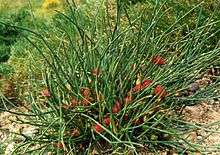Ephedra monosperma
| Ephedra monosperma | |
|---|---|
 | |
| Matured red and fleshy cones of E. monosperma | |
| Scientific classification | |
| Kingdom: | Plantae |
| Division: | Gnetophyta |
| Class: | Gnetopsida |
| Order: | Gnetales |
| Family: | Ephedraceae |
| Genus: | Ephedra |
| Species: | E. monosperma |
| Binomial name | |
| Ephedra monosperma J. G. Gmel. ex C. A. Mey. | |
| Synonyms | |
| |
Ephedra monosperma, also called Ephedra minima or dan zi ma huang (in Chinese), is small shrub in the family of Ephedraceae.
It is distributed from China to Siberia and found growing in rocky slopes or dry places.[2] Its ephedrine extract has been used in traditional medicine in China and Japan, but is banned in USA since 1994 for causing various adverse effects.[3]
Description
Ephedra monosperma is perrennial[4] small shrub that ranges 5 cm to 15 cm high, often with creeping runners. The woody stems are much branched and short, 1–5 cm, and have knotted nodes. Branchlets are spreading and slim usually with slight curved shape. Internodes of branchlets are 1–3 cm long, 1 mm in diameter.
The leaves are opposite, basal 1/3–2/3 connate their length. There is one ovule in each cone that is enclosed by two pairs of cone bracts.[5] Pollen cones, consist of 3 or 4 pairs of decussate scales with broad margin, are oblong-spherical shaped, sessile or subsessile at nodes and paired or rarely solitary.[4][6]
Bracts of pollen cones are in 2 to 4 pairs, 1/2 connate their length. It pollinates in June, has matured seeds in August,[2] and flowers from May.[4] Seed cones are solitary or opposite at nodes, sessile, and ovoid at maturity.[2] The mature cones are fleshy, red, and glaucose, 6–9 mm long, 5–8 mm across.[6]
Habitat and distribution
Ephedra monosperma is found growing in crevices of limestone, cliffs, and rocky slopes, sometimes on the rocks on slope of river valleys often with sparse Juniperus and shrub vegetation. It is also often found in dry pine forests.[4]
E. monosperma is mainly distributed in these Asian locations: China (Beijing, Chongqing, Gansu, Guizhou, Hebei, Hubei, Nei Monggol, Ningxia, Qinghai, Shandong, Shanxi, Sichuan, Tianjin, Xinjiang, and Yunnan[4]) Tibet, Kazakhstan, Mongolia, Pakistan, and Russia (Buryatiya, Chita, Irkutsk, Krasnoyarsk, Tuva, and Yakutiya[4]).[2]
Uses
Medicine
Ephedrae herbs which includes Ephedra monosperma has been used in Chinese and Japanese medicine for several thousand years.[3] The pharmacological effect of Ephedra medicine is in wide range: increase in heart rate and elevation of blood pressure against heart block or postural hypotension, constriction of peripheral blood vessels, bronchodilation against bronchial asthma, CNS stimulation against narcolepsy or depression, and urine retention against urinary incontinence.[7]
The pure alkaloid ephedrine from the Ephedra herbs is popular for effective medicine for asthma, especially because it can be given by mouth unlike adrenaline.[8]
It has been recently used in street drug and nutritional supplements using methamphetamine extracted from Asian Ephedra.[9] However, ephedrine products are now banned in U.S.A since 1994 for causing various and serious adverse effects, such as headache, insomnia, stroke, arrhythmias, myocardial infarction, psychosis, heart palpitations, cardiac arrest and even death.[3]
Tea
To make Mongolia tea, dried mature seed-cones of Ephedra monosperma are mixed with white tea or herbs, taken with or without cream and milk.[6]
References
- ↑ A. Bell & S. Bachman (2011). "Ephedra monosperma". IUCN Red List of Threatened Species. Version 2014.3. International Union for Conservation of Nature. Retrieved 19 March 2015.
- 1 2 3 4 Flora of China Editorial Committee. 1999. Flora of China, Volume 4: 1–453. Science Press & Missouri Botanical Garden Press, Beijing & St. Louis.
- 1 2 3 Kitani, Yuki, Shu Zhu, Takayuki Omote, Ken Tanaka, Javzan Batkhuu, Chinbat Sanchir, Hirotoshi Fushimi, Masayuki Mikage, and Katsuko Komatsu. "Molecular Analysis and Chemical Evaluation of Ephedra Plants in Mongolia." Biological & Pharmaceutical Bulletin 32.7 (2009): 1235-243.
- 1 2 3 4 5 6 Bachman, Steven. "Species Summary- Ephedra Monosperma." Sampled Red List Index for Plants. 12 Apr. 2011.
- ↑ Rydin, Catarina, Anbar Khodabandeh, and Peter K. Endress. "The Female Reproductive Unit of Ephedra (Gnetales): Comparative Morphology and Evolutionary Perspectives." Botanical Journal of the Linnean Society 163.4 (2010): 409-10.
- 1 2 3 Hu, Shiu-ying. Food Plants of China. Hong Kong: Chinese UP, 2005. pp. 279.
- ↑ Abourashed E, El-Alfy A, Khan I, Walker L (2003). "Ephedra in perspective--a current review". Phytother Res 17 (7): 703–12.
- ↑ Lee, M R. "The History of Ephedra (ma-huang)." MEDLINE. The Journal of the Royal College of Physicians of Edinburgh, Mar. 2011. Web. 29 Apr. 2012.
- ↑ Caveney, S., DA Charlet, and H. Freitag. "American Journal of Botany." New Observations on the Secondary Chemistry of World Ephedra (Ephedraceae). American Journal of Botany, July 2001.
